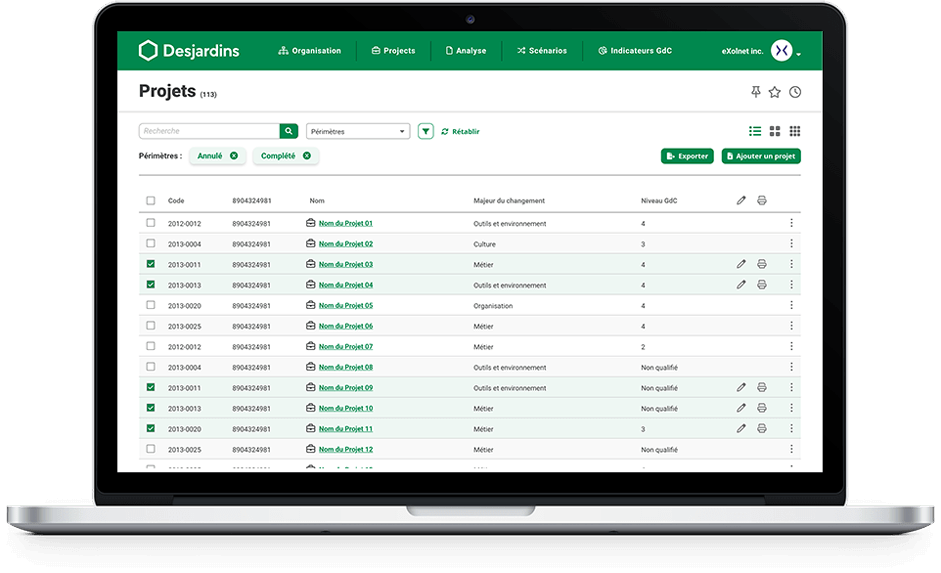Desjardins Group Change management tool

Transforming a process into a decision support tool Anticipating a project’s human impacts
With close to 900 points of service in Quebec and Ontario, Desjardins is the leading financial cooperative group in Canada. Their change management team works tirelessly to carry out change impact analyses and monitoring to help their various departments plan their projects. They asked us to design a tool that would provide an overview of their project’s human impacts and that would replace ExcelTM spreadsheets in order to increase productivity and reduce errors.
After meeting with many members from the change management team, we transferred their processes into a web-based tool to assess the impact of on-going projects using analyses and automated reports. As a result, the team can advise their clients more efficiently.
INSIGHT — What is “change management”?
It enables an organization to prepare for transformation impacts. By understanding the effects of past and future changes, we’re able to equip managers with the tools they need to make better business decisions.
For example, it could involve evaluating the impact of a technical change, such as a software update. By analyzing how this transformation could affect an organization’s resources, we can plan ahead to minimize its impact. However, defining change management remains difficult, as each business has its own processes in place.
A few figures
Our strategy
Manage changes made by a change management tool
Consult the client to understand their current process
We organized multiple meetings with the change management team to gain an understanding of their concerns and their work methods. We then documented the current process to offer both parties a common initial reference point.
Explain complex concepts through functional mockups
Mockups played a key role in this project. They enabled us to establish a common base from which the project was designed, meaning our team and our client were able to speak the same language.
Recreate the process before improving it
In order to bolster the adoption of the new tool, our priority first and foremost was to reproduce the process that was already in place. Once the new version had been mastered, we improved the tool using short iterations prioritized by the client’s business needs.
The most popular proactive methodology amongst Fortune 500 companies!
Better to be safe than sorry
Organizational management
The organizational structure of the company is imported and serves as a reference point for the tool’s other functionalities.
Project data gathering
Dozens of parameters categorized for each project allow for the context of each change to be identified, helping analysts to understand their impact.
Impact identification
Various analysis factors enable the quantification of the impact that each project will have on the different parts of an organization.
Risk analysis
A series of filters and reports allow for the identification of which parts of the organization are at risk and to provide invaluable help in decision‑making.
Optimal solution diagnostic
A simulation module makes it possible to modify a business’s current situation to identify critical points and to help analysts work out the best solution.
Encourage collaboration by making it easier

ExcelTM support
This kind of tool is very useful for analysts but can also be useful for directors and project managers. With this in mind, all reports, graphs, and tables can be exported into Microsoft ExcelTM or PDF files.

Simulation module
Regardless of all the reports available, an analyst can still find it difficult to have a good overview. The simulation module provides the flexibility needed to compare different alternatives and to find the optimal solution that will minimize change impacts across the organization.

Indicators and Dashboards
The tool offers a large selection of dashboards and indicators to facilitate reading and understanding the data. As such, should any other Desjardins department need to view these data, they may do so provided they have the appropriate permission.

Collaborative work
We use real-time project editing whereby conflicts are managed between different users, enabling them to work collaboratively.

Fast algorithms
With tens of thousands of functions that are affected by hundreds of projects comprising dozens of milestones, algorithms have been optimized to respond in a matter of seconds.